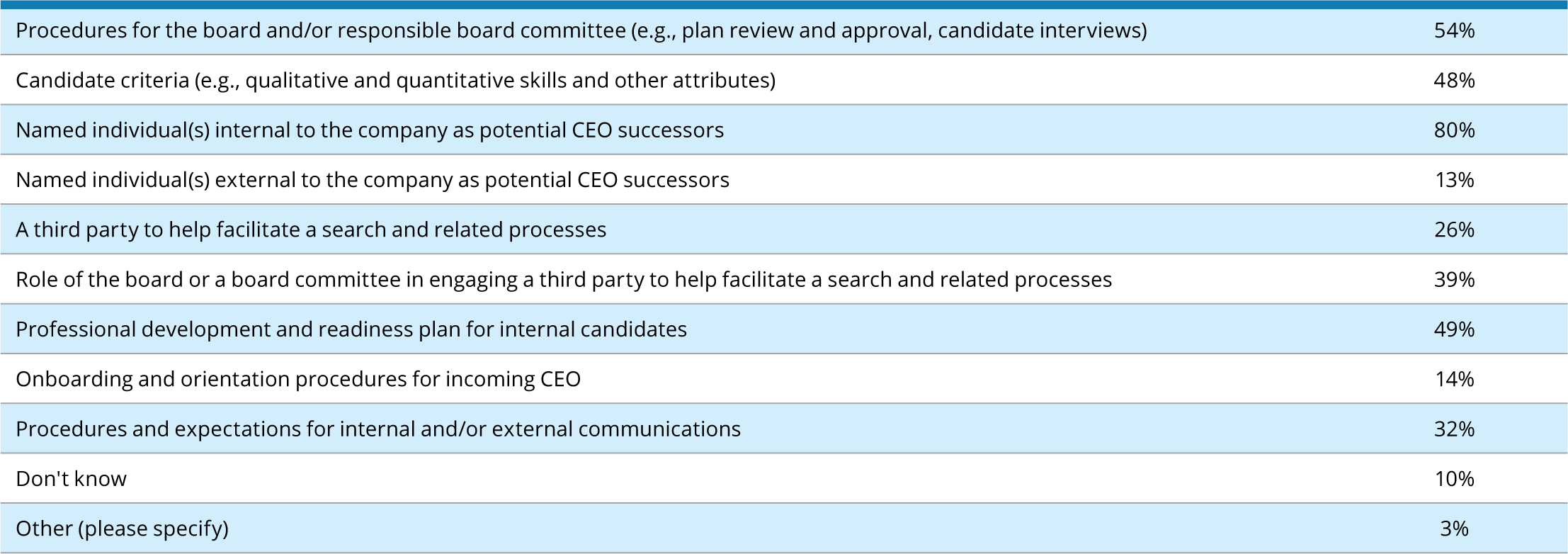CEO succession planning processes has been saved
Perspectives
CEO succession planning processes
Board Practices Quarterly, December 2023
By Natalie Cooper, Bob Lamm, and Randi Val Morrison
The CEO is, in many cases, the alter ego of the company to many of its constituencies and is inevitably intertwined with its strategic direction, operations, and reputation. It is therefore not surprising that many posit that CEO succession planning is among the board’s primary responsibilities. And in light of the potentially significant costs associated with a failed succession event and trends indicating a sharp uptick in CEO turnover, the importance of maintaining robust and formalized processes and practices to prepare for a planned or unplanned leadership change cannot be understated.
This Board Practices Quarterly presents findings from a survey of members of the Society for Corporate Governance and focuses on the CEO succession planning process, including the content of the plan, who has primary responsibility, frequency of review, and related public disclosure.
Select findings
Respondents, primarily corporate secretaries, in-house counsel, and other in-house governance professionals, represent 102 public companies of varying sizes and industries,1 and the findings pertain to these companies. The actual number of responses for each question is provided. Some survey results may not total 100%, as questions may have allowed respondents to select multiple answers. Where applicable, commentary has been included to highlight differences among respondent demographics and to highlight comparisons to any similar questions asked in prior Board Practices Reports.
In the past 1-2 years, which of the following describes disclosure and shareholder engagement as it pertains to CEO succession at your company? Check all that apply.
18% of all respondents reported “Shareholders discussed or asked to discuss CEO succession with management and/or the board,” compared to 21% responding to a similar question in our 2018 Board Practices Report. Further, the greatest variation across market caps also pertains to this answer choice, reported by 26% large-caps and 14% mid-caps.
In our 2016 Board Practices Report, 62% responded that there was no change in the level of disclosure of their company’s succession plan process, compared to 32% in this year’s survey. There is otherwise minimal change since 2016 as to any disclosure increases or decreases or the percentage of companies not disclosing their succession plan process.

Describe the involvement of your CEO, board, and/or board committee in the CEO succession planning process. Check all that apply.
Level of involvement across the CEO, full board, and/or responsible committee, or other management varies across market caps:
CEO
- Review of the plan – 54% large-cap; 71% mid-cap
- Approval of the plan – 11% large-cap; 29% mid-cap
- Development of the candidate profile – 39% large-cap; 60% mid-cap
Full board and/or responsible board committee
- Development of the candidate profile – 54% large-cap; 69% mid-cap• Interviewing candidates – 57% large-cap; 77% mid-cap
- Selection of search firm – 54% large-cap; 71% mid-cap
Other member of management
- Development of the candidate profile – 50% large-cap; 31% mid-cap
- Identification of candidates – 57% large-cap; 29% mid-cap

Which of the following is included in your planned (not emergency) CEO succession plan? Check all that apply.
A majority of respondents reported the following being included in their plans: named individual(s) internal to the company as potential CEO successors and procedures for the board and/or responsible board committee.
Nearly half of respondents reported that their plans include professional development and readiness plans for internal candidates and candidate criteria (e.g., qualitative and quantitative skills and other attributes); however, candidate criteria varies significantly across market caps (34% of large-caps and 56% of mid-caps). Further, 24% of large-caps reported their plans include onboarding and orientation procedures for an incoming CEO compared to 6% of mid-caps.

Endnotes
1 Public company respondent market capitalization as of December 2022: 39% large-cap (which includes mega- and large-cap) (> $10 billion); 55% mid-cap ($2 billion to $10 billion); and 6% small-cap (which includes small-, micro-, and nano-cap) (< $2 billion). Respondent industry breakdown: 28% financial services; 27% consumer; 25% energy, resources, and industrials; 11% technology, media, and telecommunications; and 8% life sciences and health care.
Small-cap and private company findings have been omitted from this report and the accompanying demographics report due to limited respondent population.
Throughout this report, percentages may not total 100% due to rounding and/or a question that allowed respondents to select multiple choices.
Recommendations
The never-ending story: CEO succession planning
On the board’s agenda, May 2023
Board Practices Quarterly
Insights and benchmarking data for board practices


